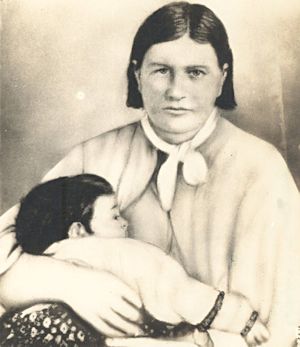Even though she was not born of Native blood, the life of Cynthia Ann Parker certainly earned recognition and respect because of her devotion to Native life, her husband and her children. It only seems fitting that her spirit be honored here.
 Cynthia was born in Clark County, Illinois and moved with her family to the headwaters of the Navasota River in Texas as a young child.
Cynthia was born in Clark County, Illinois and moved with her family to the headwaters of the Navasota River in Texas as a young child.
The family developed a community around the church of her uncle, Elder John Parker, who headed the Texas branch of the Primitive Baptist Church.
As protection against the Natives of the area, they built substantial walls around their community and created a company of Texas Rangers for the area. The settlement became known as Fort Parker.
In the Spring of 1836, Fort Parker was attacked by several hundred Caddo, Comanche and Kiowa who captured five residents of the Fort. Among them was Cynthia, who was 9 years old at the time.
Within 6 years, all the captives had been returned to their white families – except Cynthia.
Cynthia was given to a Tenowish Comanche couple who cared for her, and who raised her like their own daughter. She became Comanche in every sense; was trained in Native ways and was totally devoted to her adopted parents.
The memories of her white life quickly faded, and every attempt to ransom her was refused by the tribal council at her request.
She married Peta Nocoma, the young chief who gained fame for his many violent raids on white settlements in the territory.
While it was customary for prominent Comanche warriors to take several wives, Peta never took any wife except Cynthia – a mark of extraordinary devotion and honor for her.
They had 3 children: Quanah, Pecos and Topsannah (2 boys and 1 girl).
In December of 1860, Peta’s camp on the banks of the Pease River was attacked by Captain Lawrence Sullivan Ross. Peta was wounded, but managed to escape with their two sons, Quanah and Pecos.
Whether or not Peta survived these wounds and lived is cloudy for he is not mentioned again.
Cynthia was “rescued” along with their daughter Topsannah and the two were taken to Camp Cooper. She was identified by her uncle Isaac Parker, and subsequently taken to his farm in Birdville, Texas.
Cynthia’s every attempt to return to her people failed, and she was repeatedly caught and returned to Birdville.
Even though she refused to speak of her Comanche life, many fanciful and fictitious stories were written about this strange and mysterious woman.
“Historical fiction” was used to incite anti-Indian feelings, and these tall tales eventually became accepted as truth and fact.
Never satisfied, and never at home in a society that was foreign to her, Cynthia was shuttled from one family member to another. Her grief and longing for her lost family never left her.
In 1863, Cynthia received word that her son Pecos had died of smallpox, and only a few months later, the daughter who had remained with her died of influenza.
Heartbroken, Cynthia refused all food and starved herself to death in 1870 at the age of 43.
Only Quanah survived, and his name is legendary as the fierce, half-breed Comanche warrior chief.
In his later years, Quanah began living in peace with the whites and went on to be very prosperous.
He searched for his mother for most of his life and, upon discovering that she was dead, had the bodies of both Cynthia and Topsannah moved to friendly soil.
When Quanah died in 1911, he was laid to rest beside his devoted mother.